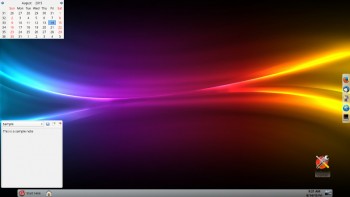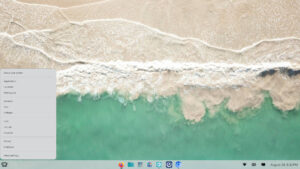Larry the BSD Guy
The BSD licensed Lumina Desktop aims to release version 1.0 in July.
It appears the sun is rising on Lumina.
Ken Moore, the lead developer for the BSD-based Lumina Desktop Environment, announced that another step towards the release of a full-fledged desktop environment for BSD variants (and Linux distros, for that matter) has been achieved with the release of version 0.8.8 yesterday.
For those of you keeping score at home, the Lumina Desktop Environment — let’s just call it Lumina for short — is a lightweight, XDG-compliant, BSD-licensed desktop environment focusing on getting work done while minimizing system overhead. Specifically designed for PC-BSD and FreeBSD, it has also been ported to many other BSD variants and Linux distros. Lumina is based on the Qt graphical toolkit and the Fluxbox window manager, and uses a small number of X utilities for various tasks.

“This release primarily contains bug fixes, interface tweaks, and some small expansions of current functionality,” Moore writes. “In addition to this, we also now have support for NetBSD systems out of the box.”
A list of developments – including feature updates, translation improvements and bug fixes – can be found on the announcement page. For further information on the desktop environment, you can visit this page.
Many of you know me as dyed-in-the-wool Xfce guy, but I’m no stranger to window managers like Fluxbox (and Openbox for that matter, which CrunchBang used back in the day). You can be sure I’m looking forward to giving Lumina a shot once it’s ready for prime time, and I’ll give you the details once I do.
One more thing: It happened again. Apparently BSD might be too scary for the general public – at least in the cafes I frequent. My early-morning MO at one cafe which, sadly, isn’t Firefly Coffee House (it’s not open this early, Caitlin — I’m sorry!) entails my setting up my ThinkPad, pushing the on button, and then going to the counter to order. Earlier this week — Monday to be exact — a guy yelled at me from the back of the cafe, “Hey, man, you’re computer’s freaking out.” I walked back to the ThinkPad to see PC-BSD going through its normal start-up paces, and I explained to the concerned fellow that this is normal for the operating system. “It’s telling me exactly what it’s doing,” I explained, though it did start me on a search for a “quiet” boot mode, if one exists. Cue the helpful BSD folks to offer multiple suggestions, which is one of the great things I am finding about this community.
See you next week.
We’re currently in the midst of our 2016 Indiegogo fundraising drive. Your support is crucial. Won’t you please visit our fundraising page and make a contribution to support FOSS Force?






I wonder if Larry or any of the other participants in the Lumina Desktop project had ever considered starting with the venerable CDE Desktop environment that was designed specifically for UNIX operating System (OS)
Here is one of the most technically sophisticated, tested and supported GUI, without need for “starting from scratch” – so to speak, and it was announced about a year ago to be Open Sourced for community development.
Even today, I have memories of preferring CDE – by comparison to many of today’s Linux focused Desktops.
@W. Perhaps one of perhaps many reasons that the Lumina Desktop didn’t start by working with the Common Desktop Environment is because when CDE was open sourced it was released under the LGPL. I suspect that one of the reasons Lumina is being developed is because the developers see a need for a DE that’s licensed under the BSD license and comes with exactly the same permissions as *BSD operating systems.
The good news is that the CDE you remember so fondly has been ported to both GNU/Linux and BSD. On the Linux side, there are currently ports for Debian, RHEL, Slackware and Ubuntu. On the BSD side, there are ports available for FreeBSD, NetBSD and OpenBSD. CDE has also been ported to OpenIndiana (an OpenSolaris derivative) and the x86 64-bit release of Solaris 11.
The project is very much alive, with work currently underway to port it to additional Linux distros, as well as other varients of BSD and Unix — all under the LGPL.
So, Mr. Anderson, you can either use CDE right now on your favorite distribution, or else in the near future. It all depends on your distro fave. 🙂
I was a very early user of PCBSD – when KDE was only (and preferred) Desktop GUI available, and support the project unequivocally, although it had become necessary to use more stable and intuitive “Desktop” Linux for required functionality on daily use basis.
If Lumina becomes quite stable and especially “fully functional” as LinuxMint KDE for example, and “aesthetically” pleasing as CDE – at least to me, then I will strongly evaluate Lumina based PCBSD for my main Desktop.
Otherwise I look afresh at good CDE based PCBSD/FreeBSD.
Yet another blunder for the free software world: instead of Lumina, LXQt and Maui joining forces to produce a single lightweight Qt-based desktop, we now have three half-baked such projects. Free software was suppose to enhance collaboration, but so far it has only enhanced division.
A. Feel free to ignore 1, 2, or even all 3 of the above if they don’t please you.
I’ll second the statement by Michael Rose: There’s no “corporation” forcing what THEY think your desktop should be, down your throat. Find what suits you, an USE it! I have seen and tried CDE, but you know what?….it’s not for me. I don’t use it, I don’t go around disparaging the creators and developers of it. I just don’t use it. Feel free to use WHAT you want…on whatever SYSTEM you want, and any TIME you want! I have switched distros and desktop environments numerous times, I have my “favorites” and I use those constantly, but I’m not bound by some licensing agreement that says I have to stay with ANY of them! And so I bounce around from time to time, and then there’s times I put away all the eye candy and use what gets the job done. And THAT dear friend is the TRUE “Freedom” in Open Source, not the price, but the freedom to DO AS YOU PLEASE!
Regarding your “one more thing,” I’ve found a fairly straightforward way to explain that to Mac users at least: simply telling them that they’ll see almost the exact same thing on their own systems by holding down Command-V during boot.
That usually induces them to try it on-the-spot, and they end up getting a better mental connection with the boot messages being hidden on most systems purely for aesthetic reasons. Suddenly you’re just a person who chooses to be tacky, rather than some poor schmuck with an ancient and weird pariah of an operating system.
The verbose boot mode on Windows, of course, not only looks quite different, but is also very tricky to trigger ad-hoc (i.e. without GPO or registry changes) from 8 onward.